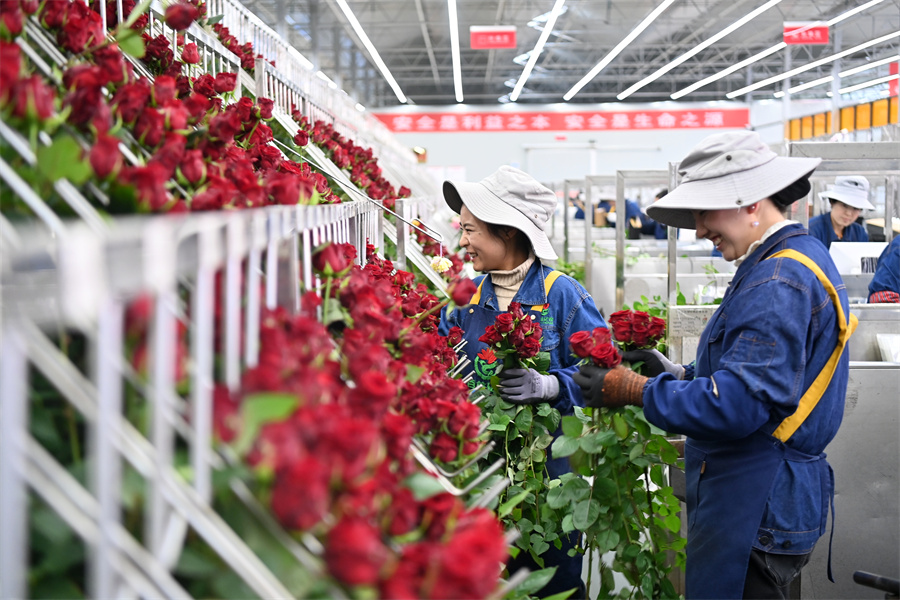
Employees sort fresh roses at Baiyi Yinong International Flower Port in Linxia, Gansu province, in November.[JIGME TENZIN/CHINA NEWS SERVICE]
Positioning the fresh-cut flower sector as a key driver of modern and smart agriculture, Linxia Hui autonomous prefecture in Gansu province is doubling down on the production and sales of its rose industry with cutting-edge planting technologies.
Even during the harsh winter months, roses continue to bloom inside the state-of-the-art smart greenhouses at the Linxia-based Baiyi Yinong International Flower Port — a result of the region's innovative approach to flower cultivation. Such innovation promises a bountiful harvest for growers, anticipating a sweet gain from Valentine's Day sales.
"Compared to outdoor flowers grown in Southwest and South China during winter, those cultivated in our greenhouses can be of superior quality," said Wu Shibin, a production employee at the flower port. Equipped with advanced technologies that allow for independent control of temperature and humidity in each section, the facility ensures a steady flower yield throughout the year, Wu explained.
The smart control systems include window-opening mechanisms, shading and insulation, misting, supplementary lighting, integrated water and fertilizer systems and heating, all of which can be managed through integrated and automated controls.
With the support of new technology and smart greenhouses, Linxia's fresh-cut roses are now able to showcase unique advantages compared with other growing areas, said Zhang Xiaoliang, an executive at the flower port, adding that the region's altitude, sunlight and humidity conditions make it an ideal environment for rose cultivation.
"Our roses are grown through soilfree methods, which, combined with advanced facilities, create a stable growing environment and can achieve consistent flower quality year-round, with stable flower colors and shapes," said Li Zetian, deputy general manager at the flower port.
Li added that the port's current rose yield is about 370 stems per square meter, compared to 150 stems for roses from Yunnan province, which are grown in soil and more affected by climate conditions.
Once beginning with sales through Yunnan's flower market, the nation's major fresh-cut flower hub, Linxia has now broken free from regional constraints and found a way to cultivate its own cut-flower business, with 70 percent of its cut flowers now sold directly across the country.
"Demand for fresh-cut flowers peaks especially around the Chinese New Year, when prices are also at their highest," Zhang said, noting that the company typically sells about five million fresh-cut roses per month during the first quarter of every year.
As Linxia's largest and most automated floral industry demonstration park, the "Chinese Rose Gigafactory" now holds 1.5 million rose seedlings covering more than 10 varieties, and produces around 200,000 fresh-cut roses daily.
In addition to a steady domestic market, Linxia's flowers are also gaining traction overseas. Last year, Linxia exported over 690,000 fresh-cut flowers, with a value of over 2.5 million yuan ($342,112), to countries such as Russia and Kazakhstan, according to local government data.
"Our primary markets are Kazakhstan and Russia, but we are also expanding into Kyrgyzstan and other markets involved in the Belt and Road Initiative," Li said. "We aim to open more international markets, which will be a crucial path for expanding our flower exports."
Li added that to ensure the safe and timely delivery of flowers to overseas markets, Linxia has tackled export bottlenecks by integrating high-quality logistics resources, building an efficient cold chain transportation system and utilizing smart monitoring equipment to track transport conditions in real-time.
Linxia's "flower economy" has successfully created an industry chain that boosts the income and prosperity of local farmers. Currently, the flower port employs over 300 staff members, most of whom come from nearby villages and the average annual income of each employee can reach 45,000 yuan.
As the second and third phases of the Port are under construction, with plans already in place for the fourth to sixth phases, the facility is expected to cover 3,000 mu (200 hectares) and produce 700 million fresh-cut roses annually once fully completed.